Optimization of Winter Irrigation under Freeze–Thaw Conditions: A Case Study of the Yellow River Delta, China
Abstract
:1. Introduction
2. Materials and Methods
2.1. Description of the Study Area and Plots
2.2. Data Measurement and Collection
2.2.1. Determination of SM and Soil Salt Content
2.2.2. Observation of Meteorological Data
2.3. Simulation Method
2.3.1. SHAW Model Description
2.3.2. Main Parameters of the SHAW Model
2.3.3. Data Processing and Acquisition of the Model
2.3.4. SHAW Model Optimization and Evaluation
2.4. Scenario Simulation
- (1)
- Irrigation was initiated on November 15.
- (2)
- A total of 8 irrigation quotas were set, i.e., 0 mm, 20 mm, 40 mm, 60 mm, 80 mm, 100 mm, 120 mm, and 150 mm.
- (3)
- The meteorological data (the temperature, wind speed, and precipitation) of Dongying City, Shandong Province, from 1965 to 2015 were used as inputs in the model.
3. Results
3.1. Calibration of SHAW Model
3.2. Validation of the SHAW Model
3.3. Response of SM to Winter Irrigation Amount
3.4. Response of Soil Temperature to Winter Irrigation Amount
3.5. Response of Soil Salinity to the Winter Irrigation Amount
4. Discussion
4.1. Effect of Winter Irrigation on SM, Temperature, and Salt Transport
4.2. Optimization and Suggestions for the Irrigation Scheme
5. Conclusions
Author Contributions
Funding
Institutional Review Board Statement
Informed Consent Statement
Data Availability Statement
Conflicts of Interest
References
- Cai, Z.; Xie, D.; Xu, H.; Wei, C.; Gao, M. Factors Influencing CH4 Emissions from a Permanently Flooded Rice Field during Rice Growing Period. Chin. J. Appl. Ecol. 2003, 14, 705–709. [Google Scholar]
- Chen, W.; Hou, Z.; Wu, L.; Liang, Y.; Wei, C. Evaluating Salinity Distribution in Soil Irrigated with Saline Water in Arid Regions of Northwest China. Agric. Water Manag. 2010, 97, 2001–2008. [Google Scholar] [CrossRef]
- Liu, M.; Yang, J.; Li, X.; Liu, G.; Yu, M.; Wang, J. Distribution and Dynamics of Soil Water and Salt under Different Drip Irrigation Regimes in Northwest China. Irrig. Sci. 2013, 31, 675–688. [Google Scholar] [CrossRef]
- Du, J.; Wang, Z.; Yu, H.; Ji, B. Optimum Winter Irrigation Amount of Subsurface Drip Irrigation in Alfalfa Grassland. Agric. Res. Arid. Areas 2020, 38, 166–172. [Google Scholar]
- Xiong, L.; Ma, F.; Fan, H.; Zhang, W.; Cui, J.; Zheng, Z. Interaction Effects of Winter Irrigation and Chemical Regulation on Lodging Resistance and Yield of Drip Irrigated Spring Wheat. J. Triticeae Crop. 2012, 32, 932–936. [Google Scholar]
- Wang, Z.; Jin, M.; Simunek, J.; Van Genuchten, M. Evaluation of Mulched Drip Irrigation for Cotton in Arid Northwest China. Irrig. Sci. 2014, 32, 15–27. [Google Scholar] [CrossRef] [Green Version]
- Harlan, R. Analysis of Coupled Heat-Fluid Transport in Partially Frozen Soil. Water Resour. Res. 1973, 9, 1314–1323. [Google Scholar] [CrossRef] [Green Version]
- Jansson, P.; Moon, D. A Coupled Model of Water, Heat and Mass Transfer Using Object Orientation to Improve Flexibility and Functionality. Environ. Model. Softw. 2001, 16, 37–46. [Google Scholar] [CrossRef]
- Flerchinger, G.; Saxton, K. Simultaneous Heat and Water Model of a Freezing Snow-Residue-Soil System II. Trans. ASAE 1989, 32, 573–576. [Google Scholar] [CrossRef]
- He, H.; Flerchinger, G.; Kojima, Y.; He, D.; Hardegree, S.; Dyck, M.; Horton, R.; Wu, Q.; Si, B.; Lv, J. Evaluation of 14 Frozen Soil Thermal Conductivity Models with Observations and SHAW Model Simulations. Geoderma 2021, 403, 115207. [Google Scholar] [CrossRef]
- Li, R.; Shi, H.; Flerchinger, G.; Akae, T.; Wang, C. Simulation of Freezing and Thawing Soils in Inner Mongolia Hetao Irrigation District, China. Geoderma 2012, 173, 28–33. [Google Scholar] [CrossRef]
- Li, R.; Shi, H.; Flerchinger, G.; Zou, C.; Li, Z. Modeling the Effect of Antecedent Soil Water Storage on Water and Heat Status in Seasonally Freezing and Thawing Agricultural Soils. Geoderma 2013, 206, 70–74. [Google Scholar] [CrossRef]
- Lu, Z.; Xian, S.; Yao, H.; Fang, R.; She, J. Influence of Freeze-Thaw Cycles in the Presence of a Supplementary Water Supply on Mechanical Properties of Compacted Soil. Cold Reg. Sci. Technol. 2019, 157, 42–52. [Google Scholar] [CrossRef]
- Liu, B.; Jia, X.; Shao, M.; Jia, Y. Assessing Soil Water Recovery after Converting Planted Shrubs and Grass to Natural Grass in the Northern Loess Plateau of China. Agric. Water Manag. 2022, 264, 107490. [Google Scholar] [CrossRef]
- Lin, D.; Wang, F.; Xu, Z.; Mao, X. Appropriate Winter and Spring Irrigations for Salt Leaching in Typical Cotton Field of Southern Xinjiang Based on SHAW Model. Trans. Chin. Soc. Agric. Mach. 2023, 54, 326–338. [Google Scholar]
- Lin, D.; Huang, X.; Xu, Z.; Mao, X. Spatial Distribution Characteristics of the Suitable Salt Leaching Quota in Typical Irrigation Areas of Southern Xinjiang Based on SHAW Model. Trans. Chin. Soc. Agric. Eng. 2023, 39, 70–80. [Google Scholar]
- Zhang, C.; Gong, Z.; Qiu, H.; Zhang, Y.; Zhou, D. Mapping Typical Salt-Marsh Species in the Yellow River Delta Wetland Supported by Temporal-Spatial-Spectral Multidimensional Features. Sci. Total Environ. 2021, 783, 147061. [Google Scholar] [CrossRef]
- Zhang, Z.; Song, Y.; Zhang, H.; Li, X.; Niu, B. Spatiotemporal Dynamics of Soil Salinity in the Yellow River Delta under the Impacts of Hydrology and Climate. Chin. J. Appl. Ecol. 2021, 32, 1393–1405. [Google Scholar]
- Liu, Z.; Feng, S.; Zhang, D.; Han, Y.; Cao, R. Effects of Precipitation, Irrigation, and Exploitation on Groundwater Geochemical Evolution in the People’s Victory Canal Irrigation Area, China. Appl. Water Sci. 2022, 13, 1. [Google Scholar] [CrossRef]
- Brooks, R.; Corey, A. Properties of Porous Media Affecting Fluid Flow. J. Irri. Drain. Div. 1966, 92, 61–88. [Google Scholar] [CrossRef]
- Campcell, G. A Simple Method for Determining Unsaturated Conductivity from Moisture Retention Data. Soil Sci. 1974, 117, 311–314. [Google Scholar] [CrossRef]
- Campcell, G. Soil Physics With Basic Transport Models for Soil–Plant Systems; Elsevier: Amsterdam, The Netherlands, 1985; Volume 14, p. 150. [Google Scholar]
- Li, J.; He, Z.; Du, J.; Chen, L.; Lin, P.; Zhu, X.; Fang, S.; Zhao, M.; Tian, Q. Effects of Winter Irrigation on Soil Hydro-Thermal Features in Desert Oasis Farmland in Arid Area during Freezing and Thawing Period. Trans. Chin. Soc. Agric. Eng. 2018, 34, 105–112. [Google Scholar]
- Fan, X.; Liu, G.; Tang, Z.; Su, L. Analysis on Main Contributors Influencing Soil Salinization of Yellow River Delta. Soil Water Conserv. 2010, 1, 139–144. [Google Scholar]
- Larson, L.; Kiemnec, G.; Johnson, D. Influence of Freeze-Thaw Cycle on Silt Loam Soil in Sagebrush Steppe of Northeastern Oregon. Rangel. Ecol. Manag. 2019, 72, 69–72. [Google Scholar] [CrossRef]
- Wu, M.; Huang, J.; Wu, J.; Tan, X.; Jansson, P. Experimental Study on Evaporation from Seasonally Frozen Soils under Various Water, Solute and Groundwater Conditions in Inner Mongolia, China. J. Hydrol. 2016, 535, 46–53. [Google Scholar] [CrossRef]
- Cui, L.; Zhu, Y.; Zhao, T.; Yang, J.; Wu, J. Soil Ion Components and Soil Salts Transport in Frozen Layer in Seasonal Freezing-Thawing Areas. Trans. Chin. Soc. Agric. Eng. 2019, 35, 75–82. [Google Scholar]
- Chen, J.; Zheng, X.; Xing, X.; Yang, J.; Hou, Y.; Jia, Z. Influence of Plastic Film Mulching on Infiltration into Seasonal Freezing-Thawing Soil. Trans. Chin. Soc. Agric. Eng. 2006, 22, 18–21. [Google Scholar]
- Phogat, V.; Skewes, M.; McCarthy, M.; Cox, J.; Simunek, J.; Petrie, P. Evaluation of Crop Coefficients, Water Productivity, and Water Balance Components for Wine Grapes Irrigated at Different Deficit Levels by a Sub-Surface Drip. Agric. Water Manag. 2017, 180, 22–34. [Google Scholar] [CrossRef] [Green Version]
- Zhao, B.; Wang, Z.; Li, W. Effects of Winter Drip Irrigation Mode and Quota on Water and Salt Distribution in Cotton Field Soil and Cotton Growth next Year in Northern Xinjiang. Trans. Chin. Soc. Agric. Eng. 2016, 32, 139–148. [Google Scholar]
- Xiao, Y.; Yang, P.; Bin, W.; Liu, J.; Guo, T. Analysis of Arid Oasis Areas Soil Nitrogen Accumulation and Winter Irrigation Effect. Water Sav. Irrig. 2018, 02, 71–82. [Google Scholar]
- Li, L.; Liu, H.; He, X.; Lin, E.; Yang, G. Winter Irrigation Effects on Soil Moisture, Temperature and Salinity, and on Cotton Growth in Salinized Fields in Northern Xinjiang, China. Sustainability 2020, 12, 7573. [Google Scholar] [CrossRef]
- Jing, Y.; Jiannan, M.; Yan, Z.; Jing, C.; Zhuofu, L. Effect of Temperature and Soil Moisture on Winter Wheat Morphogenesis and Overwinter Survival Rate. J. Northeast Agric. Univ. 2010, 41, 9–13. [Google Scholar]
- Feng, Y.; He, W.; Rao, M.; Zhong, X. Relationship between Frost Damage and Leaf Temperature with Winter Wheat after j ointing Stage. Acta Agrestia Sin. 2000, 26, 707–712. [Google Scholar]
- Tao, R.; Lu, Y.; Yu, Q.; Ma, Q.; Ding, Y.; Qian, J.; Ding, J.; Li, C.; Zhu, X.; Guo, W. Effects of Salt Stress on Physiological Characteristics and Yield of Different Salt-Tolerant Wheat Varieties. Chin. J. Eco-Agric. 2023, 31, 428–437. [Google Scholar]
- Wang, C.; Liu, X.; Liu, Q.; Liu, T. Dynamic Simulation Analysis of Soil Hydrothermal Salt of Horqin Meadow Ground in Freezing and Thawing Period Based on SHAW Model. Bull. Soil Water Conserv. 2017, 37, 322–327. [Google Scholar]

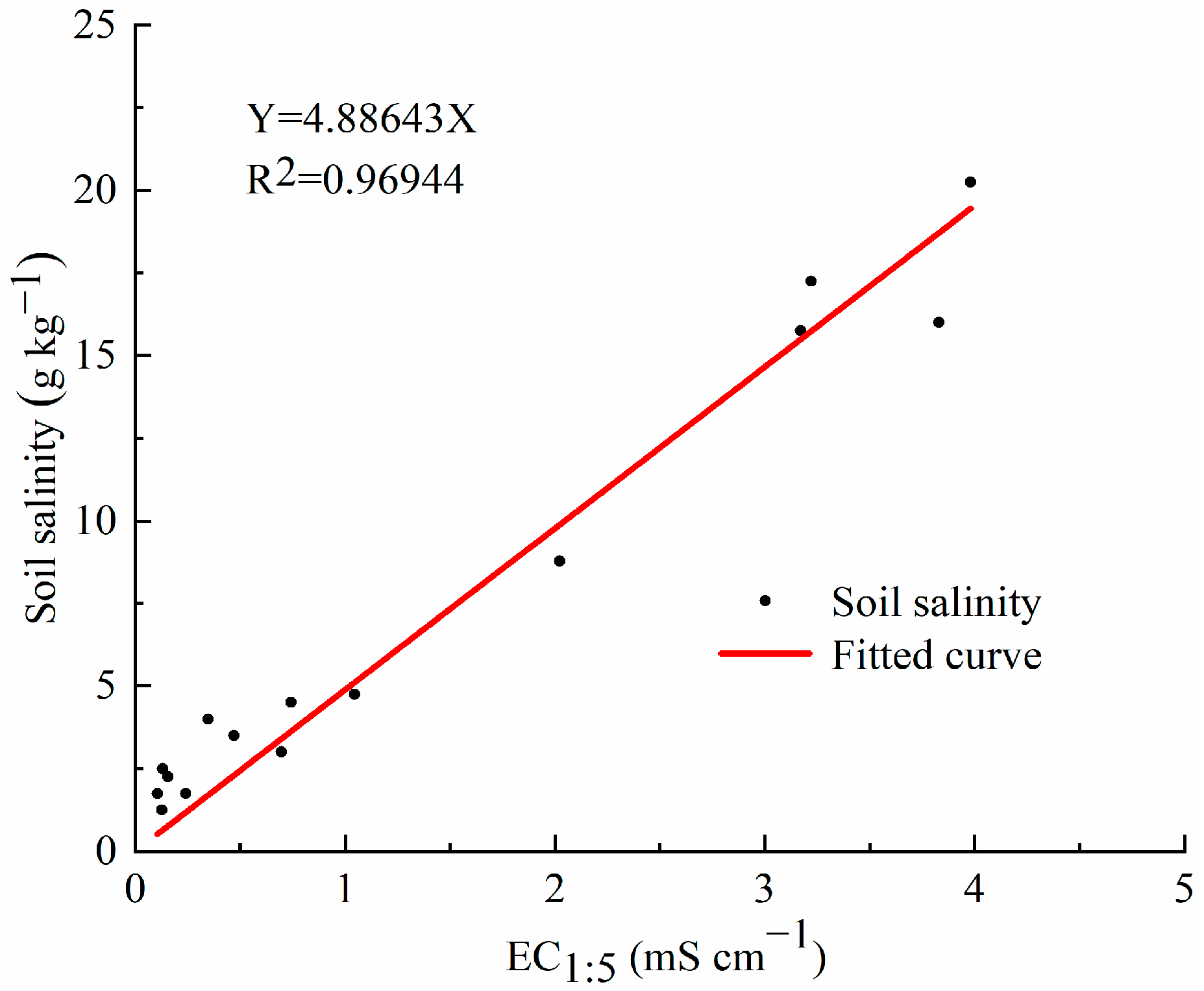
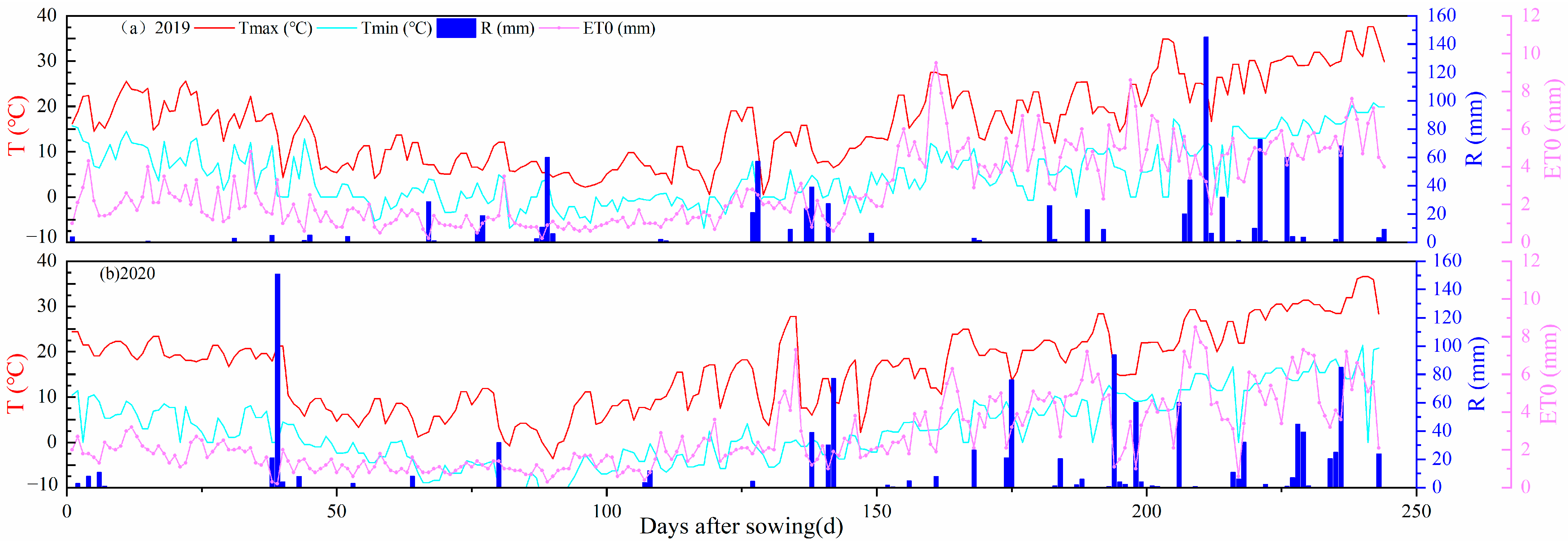


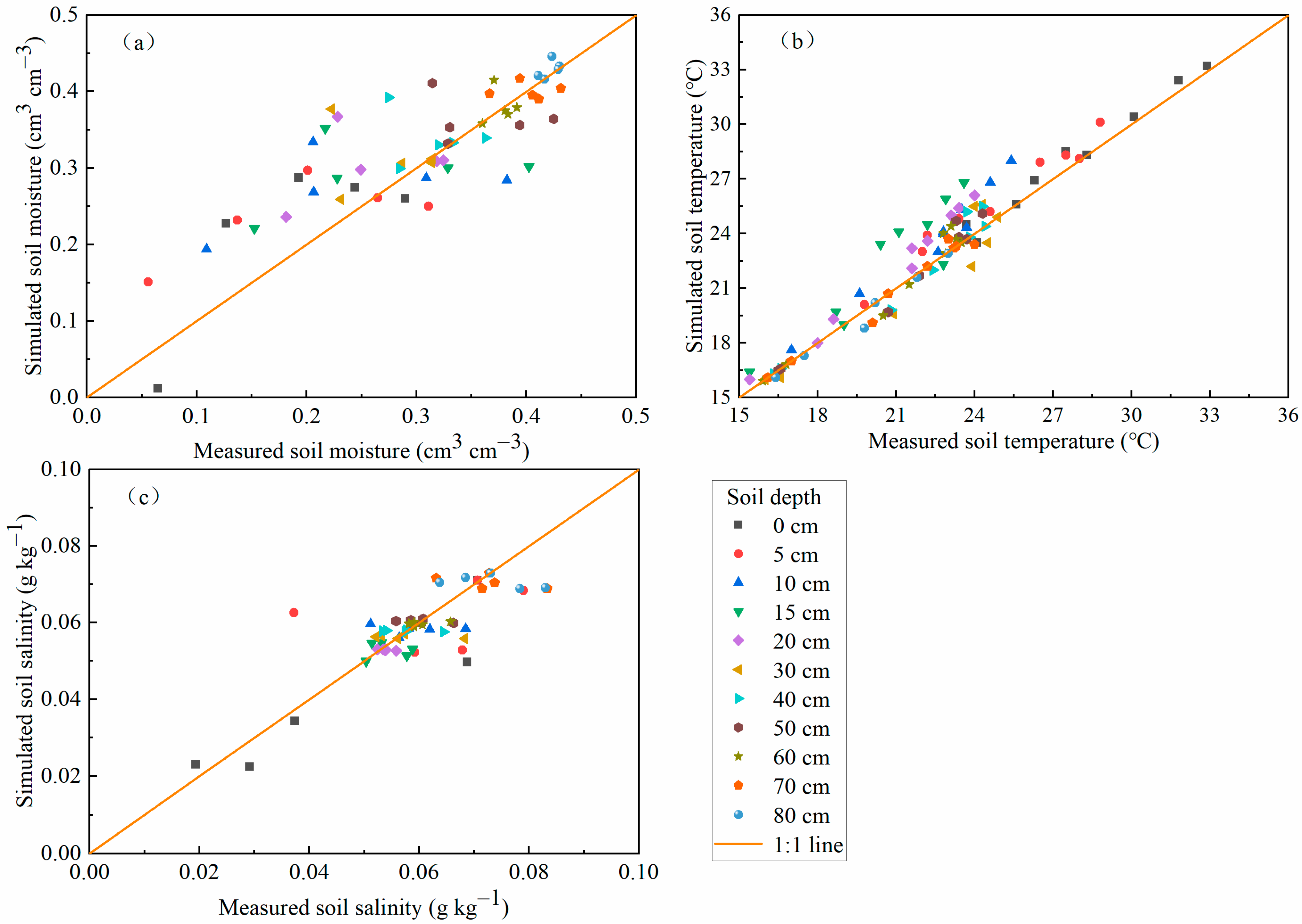
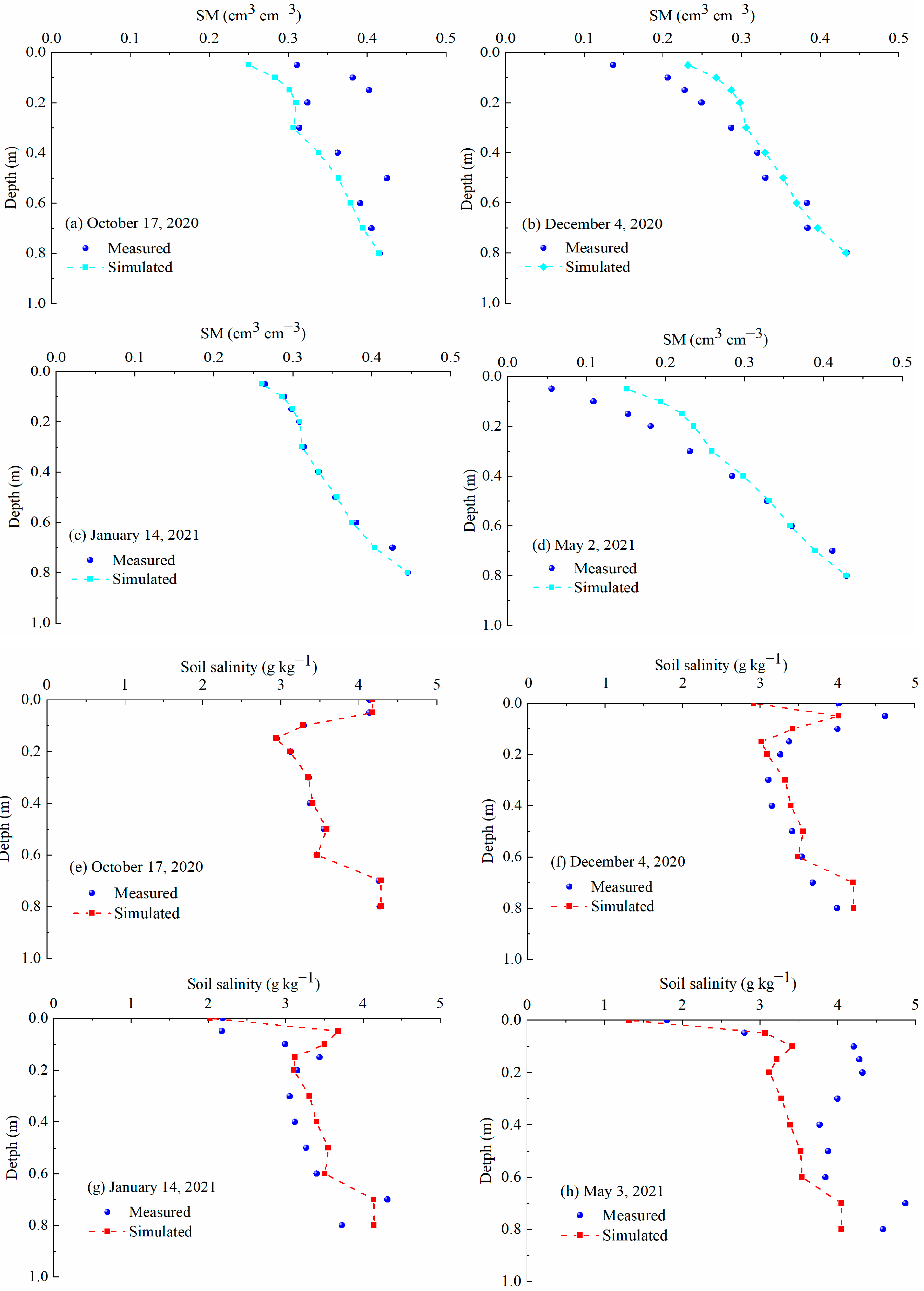

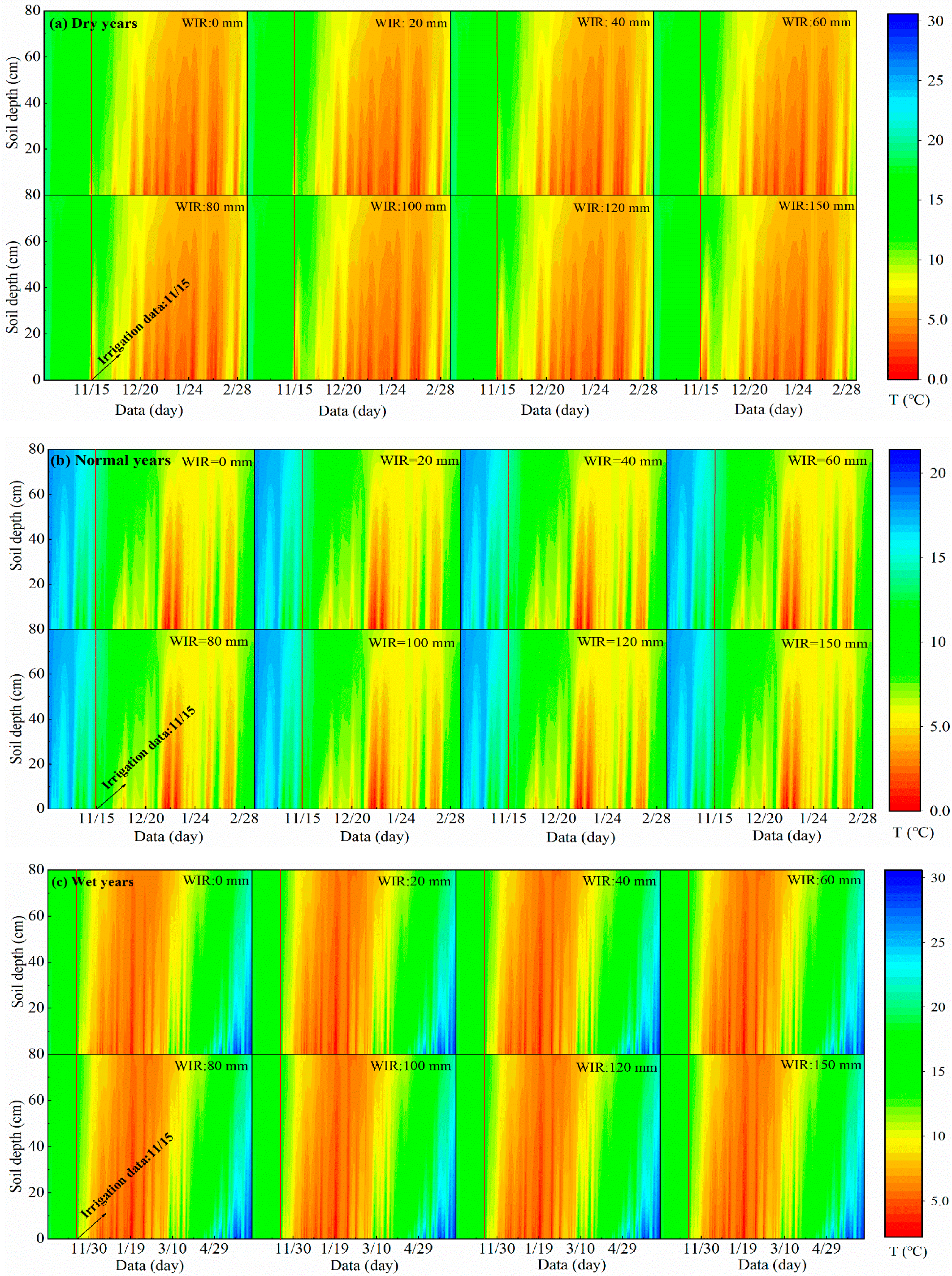


| Source | Model Parameter | Value |
|---|---|---|
| Biophysical characteristic parameters of winter wheat | XANGLE | 0.96 |
| CANALB TCCRIT/°C | 0.20 7 | |
| RSTOMO/(s m−1) | 100 | |
| RSTEXP | 5 | |
| PLEAFO/m | −200 | |
| RLEAF0/(m3 s kg−1) | 1.5 × 105 | |
| RROOT0/(m3 s kg−1) | 3.0 × 105 | |
| Field measurement | 0–40 cm sand content/% | 75.61 |
| 0–40 cm silt content/% | 21.55 | |
| 0–40 cm clay content/% | 2.84 | |
| 0–40 cm ρb/(kg m−3) | 1.457 | |
| 0–40 cm θs/(m3 m−3) | 0.42 | |
| Empirical formula | Ks/(cm h−1) | 0.958 |
| ψe/m | −0.1 | |
| b | 3 |
| Depth (cm) | ρb (g cm−3) | θs (cm3 cm−3) | Ks (cm h−1) | b | Clay (%) | Clay (%) | Sand (%) |
|---|---|---|---|---|---|---|---|
| 0–10 | 1.40 | 0.460 | 0.800 | 2.50 | 3.39 | 24.48 | 72.13 |
| 10–20 | 1.44 | 0.440 | 0.900 | 3.00 | 2.18 | 18.37 | 79.45 |
| 20–40 | 1.43 | 0.450 | 0.700 | 3.30 | 2.94 | 21.80 | 75.26 |
| 40–60 | 1.48 | 0.530 | 0.650 | 3.30 | 6.73 | 55.41 | 37.86 |
| 60–80 | 1.46 | 0.530 | 0.700 | 3.30 | 7.64 | 50.92 | 41.44 |
| SM | Soil Temperature | Soil Salinity | |||||||||
|---|---|---|---|---|---|---|---|---|---|---|---|
| Depth (cm) | ME (cm3 cm−3) | RMSE (cm3 cm−3) | NSE | Depth (cm) | ME (°C) | RMSE (°C) | NSE | Depth (cm) | ME (g kg−1) | RMSE (g kg−1) | NSE |
| 0 | 0.038 | 0.064 | 0.793 | 0 | 0.333 | 0.568 | 0.966 | 0 | 0.005 | 0.009 | 0.607 |
| 5 | −0.010 | 0.030 | 0.821 | 5 | 0.956 | 1.085 | 0.864 | 5 | −0.001 | 0.014 | 0.733 |
| 10 | 0.009 | 0.020 | 0.874 | 10 | 1.311 | 1.493 | 0.743 | 10 | −0.001 | 0.006 | 0.851 |
| 15 | 0.015 | 0.037 | 0.742 | 15 | 0.778 | 1.231 | 0.788 | 15 | −0.002 | 0.004 | 0.872 |
| 20 | 0.024 | 0.038 | 0.669 | 20 | 1.200 | 1.400 | 0.738 | 20 | −0.001 | 0.002 | 0.764 |
| 30 | 0.008 | 0.016 | 0.829 | 30 | −0.189 | 1.042 | 0.899 | 30 | −0.001 | 0.006 | 0.801 |
| 40 | 0.001 | 0.013 | 0.807 | 40 | 0.144 | 0.734 | 0.942 | 40 | 0.000 | 0.004 | 0.824 |
| 50 | 0.011 | 0.013 | 0.766 | 50 | 0.15 6 | 0.650 | 0.949 | 50 | 0.000 | 0.004 | 0.914 |
| 60 | −0.008 | 0.009 | 0.774 | 60 | 0.178 | 0.698 | 0.934 | 60 | −0.001 | 0.003 | 0.923 |
| 70 | −0.009 | 0.017 | 0.811 | 70 | −0.100 | 0.453 | 0.972 | 70 | −0.002 | 0.008 | 0.695 |
| 80 | 0.007 | 0.011 | 0.888 | 80 | −0.233 | 0.367 | 0.977 | 80 | −0.003 | 0.008 | 0.682 |
Disclaimer/Publisher’s Note: The statements, opinions and data contained in all publications are solely those of the individual author(s) and contributor(s) and not of MDPI and/or the editor(s). MDPI and/or the editor(s) disclaim responsibility for any injury to people or property resulting from any ideas, methods, instructions or products referred to in the content. |
© 2023 by the authors. Licensee MDPI, Basel, Switzerland. This article is an open access article distributed under the terms and conditions of the Creative Commons Attribution (CC BY) license (https://creativecommons.org/licenses/by/4.0/).
Share and Cite
Shan, Y.; Li, G.; Bai, Y.; Fu, Q.; Sun, Y.; Su, L.; Mu, W.; Liu, H. Optimization of Winter Irrigation under Freeze–Thaw Conditions: A Case Study of the Yellow River Delta, China. Agronomy 2023, 13, 1743. https://doi.org/10.3390/agronomy13071743
Shan Y, Li G, Bai Y, Fu Q, Sun Y, Su L, Mu W, Liu H. Optimization of Winter Irrigation under Freeze–Thaw Conditions: A Case Study of the Yellow River Delta, China. Agronomy. 2023; 13(7):1743. https://doi.org/10.3390/agronomy13071743
Chicago/Turabian StyleShan, Yuyang, Ge Li, Yungang Bai, Qiuping Fu, Yan Sun, Lijun Su, Weiyi Mu, and Hongbo Liu. 2023. "Optimization of Winter Irrigation under Freeze–Thaw Conditions: A Case Study of the Yellow River Delta, China" Agronomy 13, no. 7: 1743. https://doi.org/10.3390/agronomy13071743
APA StyleShan, Y., Li, G., Bai, Y., Fu, Q., Sun, Y., Su, L., Mu, W., & Liu, H. (2023). Optimization of Winter Irrigation under Freeze–Thaw Conditions: A Case Study of the Yellow River Delta, China. Agronomy, 13(7), 1743. https://doi.org/10.3390/agronomy13071743







